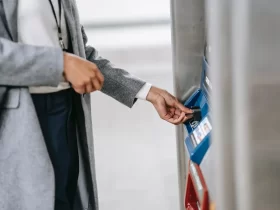Self-ordering kiosks have grown to be a vital addition in the restaurant ordering industry. Despite not being a new addition, the popularity of the technology has grown immensely. Companies that have opted to incorporate self-ordering kiosks into their businesses have seen a steady increase in success, as the powerful features they offer can increase your customers’ average ticket size.
Features of Self-Ordering Kiosks

1. Increased Check Sizes:
A key benefit of self-ordering kiosks is their ability to increase average check sizes. These kiosks can effectively promote high-margin items and various add-ons, such as extra toppings, premium sides, or combo upgrades. For instance, Taco Bell reported a 20% increase in sales from digital orders compared to traditional cashier orders, and McDonald’s saw about a 30% increase in average check size when using kiosks. This improvement is partly due to the kiosks’ ability to upsell, something that may be inconsistently done by human staff.
Must Read – Are Self-Serve Kiosks the Key to Boosting Your Restaurant’s Revenue?
2. Decreased Wait Times:
Self-ordering kiosks significantly reduce wait times. Studies have shown that if the line for a cashier is long, the majority of customers would prefer to use a kiosk. This efficiency not only enhances the customer experience but also helps reduce the potential for transmission of illnesses like COVID-19. Some establishments, like a Moe’s Southwest Grill in Pittsburgh, have even transitioned to kiosk-only formats to capitalize on these operational efficiencies.
Must Read – How Self-ordering Kiosks are Decreasing Wait Times and Increasing Customer Satisfaction
3. Enhanced Order Accuracy:
The use of self-ordering kiosks can lead to a significant decrease in order inaccuracies. Customers directly input their orders, which reduces the likelihood of miscommunication. This accuracy is crucial for customer satisfaction and reduces the burden of handling complaints and remaking incorrect orders.
4. Labor Cost Savings:
Kiosks allow for more flexible staff allocation. Front-of-house staff, who would traditionally take orders, can be reassigned to other areas that improve sales and customer service. This flexibility not only boosts productivity but also helps reduce overall labor costs, potentially making a significant difference for restaurants operating with tight budgets.
5. Improved Customer Comfort:
In the wake of the pandemic, kiosks offer a safer, contact-less ordering option, reducing the need for face-to-face interactions. This is particularly appealing to customers who prefer minimal contact for health reasons. Kiosks can be placed at various locations within the restaurant, including at tables, allowing customers to order and pay without direct interaction with staff.
6. Positive Impact on Customer Mood:
Kiosks have been found to positively influence customer mood. The interactive nature of touch screens creates an engaging and effective experience, encouraging customers to spend more time and money. This aspect of self-service technology is crucial in enhancing the overall customer experience in fast food settings.
Must Read – 5 Benefits of Adding Self-Service Kiosks to Your Restaurant
7. Adaptable Across Market Verticals:
The principles of self-order kiosks are not limited to the restaurant industry; they are effective across various market verticals. For example, airline kiosks for seat upgrades or hotel check-in kiosks for additional services demonstrate the adaptability and effectiveness of this technology in upselling and improving customer experiences in different sectors.
8. Key Features to Consider in POS Kiosks:
When selecting a POS kiosk, restaurants should consider features like intuitive menu building, prompts for upselling, integrated loyalty solutions, efficient customer notifications, and a variety of payment options including contactless ones. These features not only enhance the user experience but also contribute to increased sales and customer retention.
In summary, self-ordering kiosks offer a multitude of benefits for restaurants, including increased sales, improved order accuracy, reduced wait times, labor cost savings, enhanced customer comfort, and a positive impact on customer mood. Their adaptability across different industries further underscores their utility as a modern tool for improving customer service and operational efficiency.
Must Read – 15 Powerful Features of a Self-Serve Kiosk to Increase Customer Average Ticket-Size












Leave a Reply